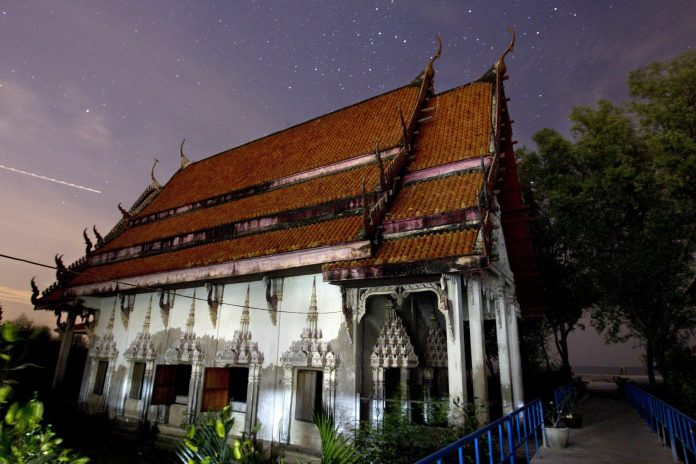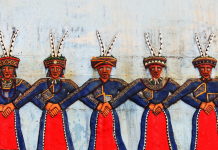
A Buddhist community fights the pushing tide
Text & Photos Brent Lewin
As the Paris Agreement on climate change comes into effect, many people are left wondering if it’s already too late to save many of the world’s vulnerable low-lying coastal communities. The science shows that sea levels worldwide have been rising at a rate of 3.5 millimetres per year since the early 1990s. This rising sea level is directly linked to global climate change due to three important factors: the warming of the oceans, or thermal expansion; the melting of glaciers; and ice loss from Greenland and Antarctica.
A recent study from the Intergovernmental Panel on Climate Change (IPCC) predicts that the oceans will have risen between 0.8 and two metres by the year 2100. More dire estimates, including a complete meltdown of the Greenland ice sheet, push sea level rise to seven metres. This becomes particularly frightening for the approximately 150 million people living in low-lying coastal areas that will either be submerged, or exposed to chronic flooding, owing to even a small increase in sea levels.
According to Climate Central, a nonprofit news organisation that analyses and reports on climate science, around nine million people in Thailand alone – approximately 13 percent of the population – will be affected by sea level rise in the coming years. Bangkok, a city sometimes called “the Venice of the East”, faces the threat of chronic flooding as rising sea levels and sinking land threaten to submerge the capital in the coming decades.

While many experts can agree that Bangkok is heading for trouble, there is much debate about when. The looming chaos may seem far off to some, but for the residents of Khun Samut Chin, a small fishing community 38 kilometres south of Bangkok, sea level rise and the realities of climate change have already shaken the community to its core.
“In Thailand, we never think to protect ourselves until the problem is staring at us in the face,” says 44-year-old monk Somnuk Attipanyo, standing in Khun Samut Chin and extending an open hand out at the Gulf of Thailand, as if to prove his point. “In Hong Kong and Singapore, they try to create land because they don’t have enough, but here in Thailand, we’ve lost our land because we don’t protect it.”
Experts say that 600 kilometres of the Thai coast has already been lost to climate change, with the Gulf of Thailand suffering the worst rate of coastal erosion. As the head of the village’s Buddhist temple Wat Khun Samut Trawat, Somnuk has been on the frontlines, battling rising water levels that have devastated the community for over a decade. The village has seen over a kilometre of land swallowed by the tide over the past 30 years, taking with it a school, a health centre, countless homes, and forcing half of the population to leave. Electricity and telephone poles poking out of the Gulf of Thailand more than 500 metres from where the shore is today offer a surreal reminder of a once-thriving community.
“I don’t know the cause of why the water has taken back the land,” admits Somnuk. “Experts have come here, studied the land, and have told me it’s related to climate change and cutting down forests. To be honest, I don’t really understand the theories and I don’t want to understand them. In life, there are people who work with concepts and theories in books, and then there are people who work with their hands on the ground. The question is what we can do now to help the situation.”

A tenth of its original size, the grounds of Wat Khun Samut Trawat stand at the edge of the water, and prior to Somnuk’s arrival, the temple was submerged, all but abandoned. Against the odds, Somnuk’s determination to revive and restore the monastery grounds has come to symbolise the community’s fight against the pushing tide.
Growing up in Samut Prakan city, just a few kilometres from Khun Samut Chin, Somnuk worked at a family grocery store and led, by his own admission, “an unproductive life”, passing his time by gambling, smoking and drinking with friends. When a close friend tragically committed suicide when Somnuk was 30 years old, it was a wake-up call to turn his life around.
“On the day my friend passed, his mother called me and asked me to become a monk, which is common practice for a short period of time in Thailand following a death,” Somnuk shares. “I only planned on staying at the temple for a day or two. But once I arrived, I started evaluating my life against the life of a monk and comparing how different they were. I immediately felt a sense of comfort and I knew I didn’t want to leave. In my twenties, if you told me I would be a monk for the rest of my life, I might have laughed,” confesses Somnuk, shaking his head.
After a year living at the temple in Samut Prakan, Somnuk met a young monk from Khun Samut Chin who told him of an abandoned temple in the sea and asked if Somnuk wanted to see it for himself.
“When I first visited, much of the temple was destroyed from water, and it was impossible to pray. I took it as a challenge to try and fix up the temple,” recalls Somnuk. He ended up staying for four months, and not only revived Buddhist life in the community, but began renovations on the temple, raising the floor of the prayer room by almost a metre to protect it from flooding at high tide.

After seeing that Somnuk was capable of living in the temple, the residents invited him to stay full time. “I didn’t have anything else to go home to, so I thought, ‘Why not?’” Somnuk adds, laughing.
Somnuk admits that it’s difficult to explain his reasons for staying. “I feel very removed from my former life, but here I have freedom: no family, no wife, no distractions, no weight on my back. My only goal in life now is to keep this temple alive. It’s important for the community, since they’ve already lost so much and face many challenges, and it makes me feel good to be a part of something positive.”
Over the course of 15 years, Somnuk and volunteers have helped by planting mangrove trees around the perimeter of the temple, as well as building a stone barrier that protects the grounds from the waves. An undated photograph showing powerful waves battering the temple hangs in the prayer room as a reminder of what he is up against.
While logistically challenging to visit, Wat Khun Samut Trawat sees a handful of mostly Thai visitors every year who are keen to marvel at this temple in the sea and leave donations for its ongoing renovations and protection.
After a peaceful night spent at the temple under the stars, Somnuk gestures at the sea that surrounds us on all sides and laments: “This all used to be a forest.” Shaking his head and pointing to the vast stretch of the Gulf of Thailand before us, he says: “Families used to have homes there. You see, when we hurt Nature, Nature comes back to hurt us”.
For more stories and photographs from the issue, see Asian Geographic Issue 123, 2017



![The Road to Independence: Malaya’s Battle Against Communism [1948-1960]](https://asiangeo.com/wp-content/uploads/2021/07/WhatsApp-Image-2021-07-26-at-11.07.56-AM-218x150.jpeg)






